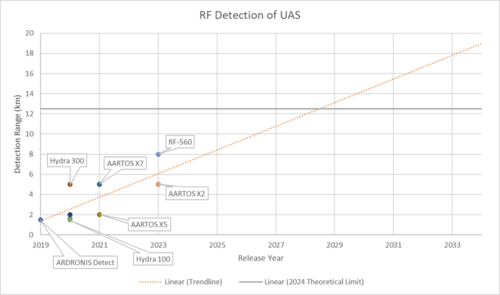Difference between revisions of "Radio Frequency Counter UAS System"
(Created page with "Roadmap Creators: [https://www.linkedin.com/in/allisontsay/| Allison Tsay], [https://www.linkedin.com/in/conor-briggi/| Conor Briggi], [https://www.linkedin.com/in/johannesgalatsanosdueck/| Johannes Galatsanos] Time Stamp: 10 October 2024 =Radio Frequency Counter UAS System= ==Roadmap Overview== ==DSM Allocation== This would be related to the following existing roadmaps: ==Roadmap Model using OPM== ==Figures of Merit (FOM)== ===Battery Energy Density FO...") |
|||
| (40 intermediate revisions by 2 users not shown) | |||
| Line 1: | Line 1: | ||
Roadmap Creators: [https://www.linkedin.com/in/ | Roadmap Creators: | ||
* [https://www.linkedin.com/in/samyoungdale Sam Youngdale] | |||
* [https://www.linkedin.com/in/emerson-c Chris Emerson] | |||
* [https://www.linkedin.com/in/jumpei-sakamoto-8a1b90294 Jumpei Sakamoto] | |||
Time Stamp: 10 October 2024 | Time Stamp: 10 October 2024 | ||
| Line 8: | Line 12: | ||
==Roadmap Overview== | ==Roadmap Overview== | ||
Counter-Unmanned Aircraft Systems (C-UAS) are technologies developed to detect, track, and neutralize unmanned aerial vehicles (UAVs) in situations where they pose security threats. With the proliferation of drones around the world, C-UAS is essential to the future airspace security landscape. C-UAS are modular and interoperable with numerous platforms. Demonstrated technologies include radar, electro-optical/infrared, acoustic, and radio frequency sensors for drone detection, as well as communication signals jamming, cyber takeover, and directed energy applications (laser and electromagnetic) for drone mitigation. Due to the variety of C-UAS configurations, our roadmap focuses on radar detection and radio frequency (RF) jamming. | |||
[[File:Detection_overview.jpg|frameless|600px]] | |||
<br> | |||
https://www.caci.com/cuas | |||
==DSM Allocation== | |||
[[File:DSM_2RFC.png|frameless|1000px]] | |||
The above 2RFC tree shows the relationship between some systems related to the Counter UAS system that uses radio frequency as for detection and defeat. This tree says that the Counter UAS system consists of the detection system (3RFD), defeat system (3RFJ), classification & tracking system (3CTS), and command and control system (3CCS). In addition, these subsystems require several components such as an RF antenna (4RFA), RF jammer (4RFJ), a processor for classification and tracking (4CTP), command center (4CMC), and so on. As this DSM shows, The DSM indicates that each component is coupled to function as an RF counter UAS system. | |||
==Roadmap Model using OPM== | |||
[[File:OPD_2RFC.jpg|frameless|800px]] | |||
[[File:OPL_2RFC.png|frameless|500px]] | |||
== | ==Figures of Merit (FOM)== | ||
[[File:FOM Table_2RFC.PNG|frameless|1000px]] | |||
The table above summarizes a number of different Figures of Merit (FOM) for the C-UAS System. The complete system that detects and defeats will have similar FOMs on either side of the chain, and we've selected to focus on Detect as the key FOM. Detect ranges are one of the more widely publicly available data metrics for such systems. However, each entity may not utilize the same metrics for comparison. This study makes the assumption that detection range metrics from different suppliers are one-to-one. | |||
[[File:FOM_table_2RFC.png|frameless|600px]] | |||
Charting a range of C-UAS RF Systems from worldwide suppliers shows an increasing detection range versus time with a wide data spread. | |||
[[File:FOM_graph_2RFC.png|frameless|500px]] | |||
[[File:State_2RFC.png|frameless|500px]] | |||
Latest revision as of 04:01, 10 October 2024
Roadmap Creators:
Time Stamp: 10 October 2024
Radio Frequency Counter UAS System
Roadmap Overview
Counter-Unmanned Aircraft Systems (C-UAS) are technologies developed to detect, track, and neutralize unmanned aerial vehicles (UAVs) in situations where they pose security threats. With the proliferation of drones around the world, C-UAS is essential to the future airspace security landscape. C-UAS are modular and interoperable with numerous platforms. Demonstrated technologies include radar, electro-optical/infrared, acoustic, and radio frequency sensors for drone detection, as well as communication signals jamming, cyber takeover, and directed energy applications (laser and electromagnetic) for drone mitigation. Due to the variety of C-UAS configurations, our roadmap focuses on radar detection and radio frequency (RF) jamming.
DSM Allocation
The above 2RFC tree shows the relationship between some systems related to the Counter UAS system that uses radio frequency as for detection and defeat. This tree says that the Counter UAS system consists of the detection system (3RFD), defeat system (3RFJ), classification & tracking system (3CTS), and command and control system (3CCS). In addition, these subsystems require several components such as an RF antenna (4RFA), RF jammer (4RFJ), a processor for classification and tracking (4CTP), command center (4CMC), and so on. As this DSM shows, The DSM indicates that each component is coupled to function as an RF counter UAS system.
Roadmap Model using OPM
Figures of Merit (FOM)
The table above summarizes a number of different Figures of Merit (FOM) for the C-UAS System. The complete system that detects and defeats will have similar FOMs on either side of the chain, and we've selected to focus on Detect as the key FOM. Detect ranges are one of the more widely publicly available data metrics for such systems. However, each entity may not utilize the same metrics for comparison. This study makes the assumption that detection range metrics from different suppliers are one-to-one.
Charting a range of C-UAS RF Systems from worldwide suppliers shows an increasing detection range versus time with a wide data spread.







